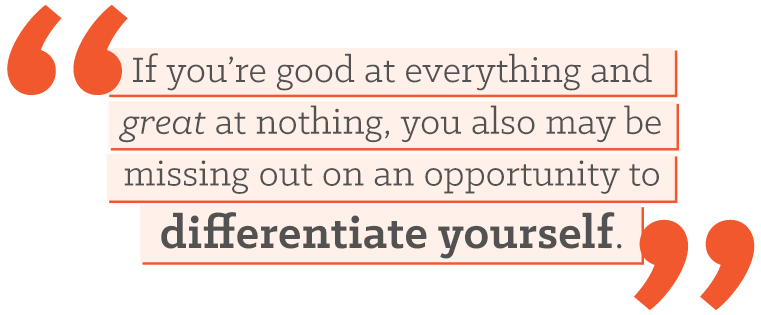How to Get Unstuck in Your Career

“I feel stuck. Where should I go from here?”
It's not uncommon to feel like there's no obvious next step in your career. It's hard work to guide yourself, especially when you're walking into the unknown.
So what do you do when you feel stuck? Do you jump ship? Apply for a new role within your company? Or just stick it out? In the right context, any of those options could work out just fine. But how do you know which direction is right for you?
If you're in marketing or a part of a big team, chances are you work with individuals with many different skill sets. Maybe you sit next to a woman named Tracie who's a jane of all trades. It seems like there's nothing she can't do! Your other co-worker, Seth, might be the go-to-guy for all things analytics and reports. Sometimes he even holds team workshops on metrics and reporting tools.
Despite their differences, both Tracie and Seth are most likely equally valued by the company. Their roles represent two common directions an employee might pursue in one's career, depth and breadth, and both are excellent paths to get yourself unstuck.
What's the Difference Between Depth and Breadth?

While both directions are hugely valuable, there are some key differences worth explaining. Let's take a closer look ...
- Seeking Depth: This path requires you to be constantly innovating and learning to strengthen your specialty. Perhaps you've set a goal to one day become one of the top 1% in the world who knows how to do what you do -- until there's no one left who can teach you. You are the thought leader on this subject, and thus you are extremely valuable to any company who needs this skill.
- Earning Breadth: A person who pursues this direction will gain experience in many different areas of his or her industry. After getting good (ideally great) at your job, pursue another area. The more experience you have in different facets of marketing (or other business), the better you understand how the pieces fit together. It also means you can advise others on multiple areas of marketing. This could be helpful in both future management roles and strategic leadership roles.
Ideally, most teams will have healthy mix of people pursuing both depth and breadth. People may also choose to switch between the two over time in order to have a wide skill set as well as a particular area of expertise. In the past, this has been referred to as a “T-shaped” person.
To figure out what's right for your own career development, let's dive into the values of each direction and how to know which could be right for you.
How to Get Unstuck in Your Career by Finding Depth or Breadth
How to Achieve Mastery via Depth

If you want to figure out if finding depth is the right path for you, the first piece to consider is whether you've truly gotten all the developmental value you can out of the role you have today.
This could be a hard question to ask, especially if you're so burnt out it seems like there is nothing left to learn. That can be dangerous. In that case you need to ask yourself, “Is there no more learning opportunity, or is there no more obvious learning opportunity?”
Why is this so important? It's really easy to mix up moments when you're tapped out of learning, and moments when you've simply plateaued. In fact, they can often look exactly the same.
Think about it: What makes a topic advanced? It's not obvious. It's difficult to understand. Very few people understand it. It takes serious skill, effort, and brainpower to acquire that advanced knowledge. And without a significant foundation, you wouldn't have the opportunity to learn it.
In other words, becoming “stuck” is an instance in which you're actually approaching mastery. Seth Godin goes into this idea in his book The Dip. The key point it shares is that as one progresses toward mastery, the individual often first hits a “dip,” or a point when continued learning now requires significant effort and time -- much more than it took to begin learning the skill in the first place.
The reality check? This is the obstacle that's in front of everyone who strives to move past general proficiency. It's valuable to expect this dip, if only as a way to recognize the difference between a natural obstacle in your progression (when learning becomes more challenging) vs. a lack of learning opportunities overall. If you mistake the former for the latter, you could be keeping yourself from a valuable opportunity for advancement.
The other piece that makes achieving mastery so challenging -- and thus so valuable -- is the fact that as you progress, there will be fewer and fewer people who can teach you and help you improve. You're valued for the very fact that the level of mastery you possess is uncommon and rare.
Now you are the one that can advise others. People will come to you to better understand this skill or learn it for the first time. If anyone needs an expert in this area, they will come to you.
How to Build a Foundation via Breadth

Another equally valuable path is pursuing breadth. By holding many different roles over time, you'll get a wide context that serves as an investment for the long term. In fact, moving around horizontally could eventually become your strategy to move up.
Think about it: Have you ever made a structure out of popsicle sticks -- perhaps in grade school or summer camp? Pretend you want to build a structure that can reach four or five feet high. What do you need to build first before you can start building up? A wide foundation.
Take it back to marketing: A wide foundation that includes strong business context and breadth of marketing skills could be the very thing that helps you expand up into a strategic leadership role. When you have experience doing many different pieces within your industry, you'll be much more likely to understand how all the pieces fit together. That's the type of context that supports a person in strategic decision making, program management, and more.
Interested in going into management one day -- perhaps to lead a big team? It can be smart to hold off on management until you have that wide foundation. That wide context you get from having multiple roles might be extremely helpful in being able to manage and mentor people of various expertise down the line, as well as make it easier to move around within leadership roles long term. After all, it's easy to train someone who has a job you once had.
Sounds great? Before you act, let's discuss the downside as well.
When going for breadth, you risk walking away with shallow knowledge for each area. For example, it's easy to get excited about the next thing before you've gained substantial knowledge in the role you have now. Don't let feeling stuck be what forces you to move to a new role prematurely. Get all the value you can first.
Similarly, if you're good at everything and great at nothing, you also may be missing out on an opportunity to differentiate yourself. It's a good idea to pick one of your skills to be your top skill, and invest the most time in that area.

If this feels like the right path for you, the best way to pursue breadth is through a corporate mobility program. It may be a formal program, or it may be casual. Either way, understand the process you should pursue to be considered for a new role on the team. Then, make yourself an obvious candidate. In other words, do your best to demonstrate some of the skills needed in the new role while in your current role.
Evaluating an internal candidate is nearly exactly the same as an external candidate. The hiring manager needs to make the case that you will be a fit, so you need to give her a dozen reasons for why you are.
So how can you get that early experience? Here are a few ideas:
- Do a side project. This is a great way to show early value, as well as demonstrate that you will be successful at the new role's activities by doing a few of them now.
- Get to know the team. Shadow some meetings. Get to know who the people on the new team are, how they like to work, and what they would be looking for from you in the new role. Put together a plan.
- Think through what you want to achieve in the first 30-90 days. Based on that, outline the strategy you would take if you were to earn the new role. Now the manager can visualize the impact you could have.
Ready to Own Your Career?
Regardless of your path, there's always one element that's going to be the biggest factor in your career no matter what you do: the unknown.
You never know how your team or company will change over time, whether will it grow, shrink, or change priorities. You never know if there will one day be a new role you'll go after that takes you in a new direction. You never know if one day you'll fall in love with an area of expertise.
As long as you stay in the driver's seat of your own career, you'll be able to roll with the punches and make the best decisions for you in the moment. Defining something as ambiguous as a career path means to pick the best path that works for you today.
Feeling stuck in your career? Register now for HubSpot's new career growth assessment and we'll notify you when it's ready.


0 Comments:
Post a Comment
Subscribe to Post Comments [Atom]
<< Home